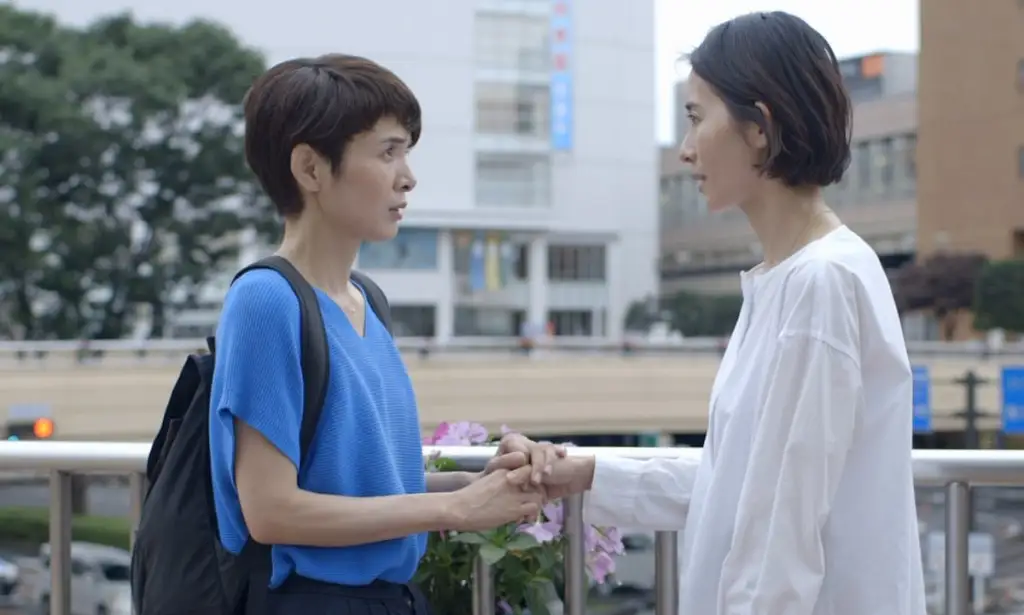Ryusuke Hamaguchi seems endlessly fascinated by serendipity and fate. His characters’ lives hinge on chance meetings, on seemingly small slips or mistakes that end up having huge consequences, and on the endless frustration of reliving certain moments and wondering what might have happened if you’d just done one small thing differently.
This was most brilliantly on display in Happy Hour, his five-hour film about the everyday lives of a group of thirty-something Japanese women that, amazingly, almost never felt too long. It was less effectively deployed in Asako I and II, which relied too much on odd plot contrivances and contained characters that felt more like plot machinations than actual people. Wheel of Fortune and Fantasy, a collection of three short films connected only by theme, falls somewhere between those two. When it’s not working, it can feel insufferable. But when it works, it’s brilliant.
The connecting themes are, not surprisingly, chance, fate, and the question of what it means to be happy as an adult (or if such a thing is even possible). In the first film, a long and frank conversation between two women friends in a taxi transitions to reveal unexpected details about both of their romantic relationships. In the second film, a university student pressures his older, married lover to seduce a professor with the goal of destroying the professor’s reputation, leading to a lengthy scene in the professor’s office that quickly takes a turn for the bizarre. And in the final film, mistaken identities and chance meetings lead to moments of revelation and pure joy for two late-thirties women, in the story that feels most strongly connected to Happy Hour.
Hamaguchi is mostly content to sit back and let his characters talk, often in semi-public spaces, where the lack of privacy adds tension to the conversation. The first film’s taxi conversation begins with the driver glancing in the rear view mirror at the two women, who grow increasingly frank in their discussion of relationships and sex, and I felt nervous the entire time that the driver might, at some point, choose to intrude. The second film’s intensely awkward seduction scene happens with the professor’s door open and students passing by loudly in the hallway outside, which makes everything even odder. The third film’s conversation happens mostly in a private home, but there’s the sense that this privacy could be interrupted at any moment by family members or by a delivery person (and it is).
My problems with the first film were mostly related to the casting of Kotone Furukawa, who was twenty-four at the time of shooting but is styled in the film to look like a teenager, which makes it jarring when we learn that she was supposedly in a relationship with a much older man two years before. She is also given dialogue better suited to a jaded woman in her thirties who is slowly realizing that she has a tendency to sabotage all of her relationships—again, jarring and not exactly believable when the character looks and moves like a teenager. Furukawa’s lines have that “characters psychoanalyzing themselves” quality that often appears in Japanese films and novels (in which characters talk at great length about who they are instead of showing us who they are). Her performance is fine, but the affect is grating and her characterization feels like a plot contrivance, with the overall structure of this first film reminding me more of a standard soap opera.
The second film begins with an equally annoying, but arguably more realistic, character—the young and utterly self-centered college student who thinks nothing of pressuring his lover into seducing his former professor as an act of revenge. The scene between the professor and the woman begins with an odd, stilted quality—the woman is clearly uncomfortable and speaks her “seductive” words robotically, while the professor responds with an equally flat affect. But then at some point things change—the woman reads aloud a painfully bad sex scene from the professor’s Akutagawa Prize-winning book, and gradually both actors’ body language and words shift. The scene is strange, but it grows steadily more intriguing, and by the end of it we feel like we’re actually listening in on a very private conversation. It recalls the lengthy “workshop” scene in Happy Hour that also began as an exercise in patience but grew more mesmerizing the more time we spent in that space with those characters.
It’s the third film, though, that reveals Hamaguchi’s brilliance as both a writer and a director. Two women brought together by chance discover surprising things about each other and engage in a game of role play that allows both of them to finally say things they’ve always wanted to say. They wonder what it is to be happy, and why they’ve lost the passion they once had. For a long, long moment they simply stand on a bridge, gripping each other’s hands and staring into each other’s eyes as they speak thoughts that you get the sense they’ve never been able to voice openly. The genuine joy and surprise on both of their faces throughout this film is deeply moving. I’m almost tempted to recommend that audiences just watch the third film, so far removed is it in quality from the other two.
It feels like a low bar to set, but it’s remarkable how rare it is in cinema to feel like a fly on the wall listening to a conversation about things that matter to people who are truly speaking from the heart, who are not simply trying to move a plot forward or create drama where none exists. Hamaguchi doesn’t quite achieve that with all the chapters of Wheel of Fortune and Fantasy, but when he does, it’s electrifying to watch.
